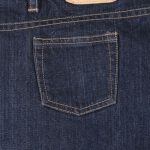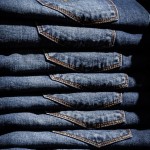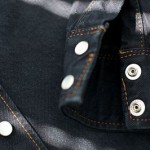
by MakeYourOwnJeans | denims, jeans |
When researching the different types of denim, you may come across a term called “selvage.” It’s certainly not as popular as dry or raw denim, but many companies still use selvage denim in their products. Selvage denim is a type of cotton twill fabric — just like raw or dry denim — that’s woven together to create a stronger, more durable textile. What makes it unique, however, is the way in which it woven. Selvage denim is created through the use of a single continuous cross-yard called the weft. The person or people creating selvage denim weave the weft back and forth through the warp upright warp beams, never cutting or breaking the single weft. In most cases, the edges feature a contrasting warp, such as red, allowing the creator to see exactly where the weft begins and where it ends. While there are several different methods for creating selvage denim, many people prefer to use shuttle looms. This otherwise simple tool weaves a narrow 30-inch fabric back and forth; thus, creating the unique pattern of selvage denim. Because the shuttle loom uses fabric that’s roughly half the size of a shutlleless loom, longer pieces of fabric are required (roughly three yards at minimum. In an effort to produce more denim and eliminate waste, companies often create jeans using wide denim that have a straight outseam. This allows them to utilize the full width of the fabric, including the edges. Selvage denim is frequently used in the production of premium, high-end jeans, as it shows the finished edges in a contrasting color as opposed to the overlocked edges on traditional...

by MakeYourOwnJeans | Uncategorized |
May 20 isn’t just another ‘spring’ day. It’s also the birthdate of blue jeans (we’re not kidding). Exactly 142 years ago to this day, Levi Strauss and his business partner Jacob Davis were granted a patent for copper-riveted trousers, which later became known as blue jeans. This sparked a growing trend in which men and women of all ages were eager to buy and wear blue jeans. Blue jeans are now the most commonly worn type of pants in the world, and for good reason: they are comfortable, stylish, durable, and can be worn for a variety of different occasions. You can even dress up a pair of jeans for formal occasions simply by pairing them with the right shirt, jacket and pair of shoes. But let’s take a few steps back to reflect blue jeans and how they came to be such as iconic fashion item. Levi Strauss — the proclaimed inventor of the blue jeans — wasn’t some experienced fashion designer, nor did have any special garment-making skills. Instead, he was a savvy businessman and entrepreneur, which he expressed by capitalizing on California’s Gold Rush. Strauss opened a small shop in which he sold supplies to gold prospectors. Reports indicate that one of Strauss’ customers, Jacob Davis, often purchased cloth fabric to make trousers for railroad workers. These trousers were stronger and more durable than other trousers, allowing them to stand up under the stress of railroad work. Here’s the problem, though: Davis didn’t have the time nor the financial means to continue producing these trousers, so approached Strauss with a proposition: the two would patent Davis’...
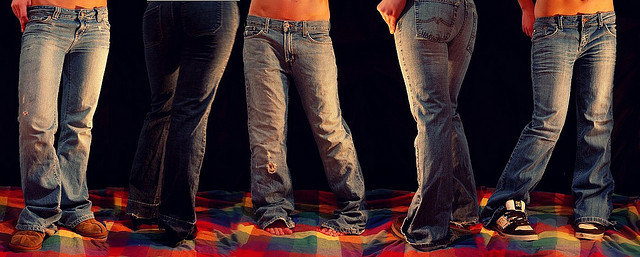
by MakeYourOwnJeans | denims, jeans |
It’s no secret that the majority of jeans produced today are made of denim. Whether they are straight-leg, slim-fit, low-rise, boot-cut, etc., chances are they are made of denim. This has become the defacto material of choice among companies that produce jeans. But what exactly is denim? And why do so many companies prefer it? These are just a few of the many questions that we’re going to answer today. Denim is essentially a type of cotton twill textile that’s characterized by the passing of the wefts. In order for denim to be created, the weft of cotton twill must pass under two or more warp threats; thus, creating a woven fabric with two diagonal crossing patterns. So in other words, denim is nothing more than cotton that’s been wrapped and woven to in a specific manner. As long as the wefts are passed in a honeycomb pattern, it can essentially be called denim. If you look closely at a pair of indigo (dark blue) colored jeans, you’ll notice the inside is actually white. This is somewhat confusing since the outside maintains its distinct indigo color. This color variation is due to the fact that the core of the warp threads remain white throughout the dyeing process. So even though the exterior of the twill threads are indigo, the insides are white. It’s believed that most dry denim is sources from the USA, Zimbabwe and Japan, although there are several other countries known to grow cotton and produce denim. The USA, however, remains the world’s leading supplier of denim, thanks largely in part to its climate and landscape that’s...

by MakeYourOwnJeans | denims, Fashion, jeans |
In the market for a new pair of jeans? Finding the “perfect” pair of jeans can be grueling, daunting task. You may spend an entire day shopping at various department stores all to no avail. And even if you happen to a find a pair you like, they may not be the right size. To make this task a little easier, we’ve compiled a list of things to consider when shopping for a pair of jeans. Color When shopping for a new pair of jeans, pay close attention to the color. The most commonly worn colors are light blue and indigo. However, you’ll find jeans are available in a wide range of different colors, some of which include red, yellow, black, green, and pretty much every other color under the rainbow. Opting for one of these colorful varieties is a fun way to express yourself while stepping away from the normal trend. With that said, be conscious of the color of jeans and how it affects the rest of your outfit. Fabric Similar to cotton corduroy, denim is the single most commonly used fabric in the production of jeans. It’s soft, durable, long-lasting and inexpensive, making it the ideal choice for jeans. However, jeans are also available in a cheap, coarse type of thick cotton cloth, known as dungaree. Dungaree jeans were popular back in the 1700-1800s in India, but they’ve since been replaced with denim. You can still find dungaree jeans available for sale, although most companies have switched over to denim. Cut You can read more about the different jean cuts by checking out some of our...
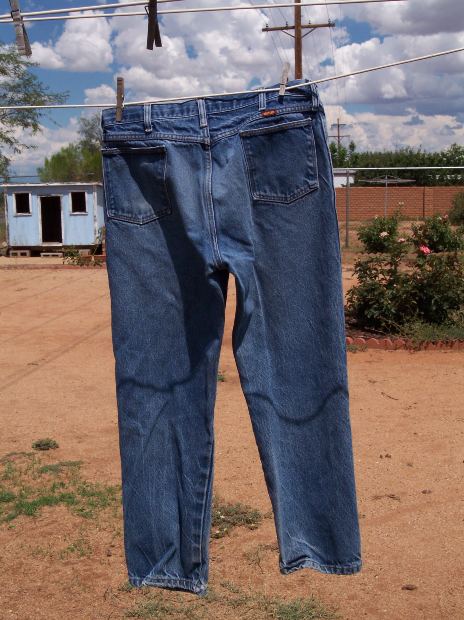
by MakeYourOwnJeans | jeans |
No, the title is this blog post is not a typo. You really can make a pair of denim jeans softer by using salt. All it takes some traditional table salt, water and a little bit of free time. If you’re interesting in creating softer denim jeans, keep reading for a step-by-step walkthrough on this process. First and foremost, it’s important to note that most jeans will naturally become softer as you wear and wash them. This isn’t something that happens overnight, but after wearing and washing the same pair of denim jeans for months on end, they will eventually feel softer than before. This is due to the fact that machine washing wears down the denim fibers, making the smaller, smoother and less rough. You can speed up this process, however, through the use of good old fashioned salt. To make your jeans softer using salt, fill a large bucket with one gallon of lukewarm water and one cup of table salt. Stir the salt around so it’s evenly distributed throughout the water and not settling at the bottom of the bucket. After stirring the saltwater solution, place your denim jeans inside, pushing them to the bottom so they are completely submerged underwater. Now comes the waiting game. Depending on the current state of your jeans, and just how soft you want them, you’ll need to let them soak in the saltwater solution for two to four hours. The longer they soak, the softer they will become. So, go watch a movie, run errands, or do something else to pass the time while your jeans are soaking up...







